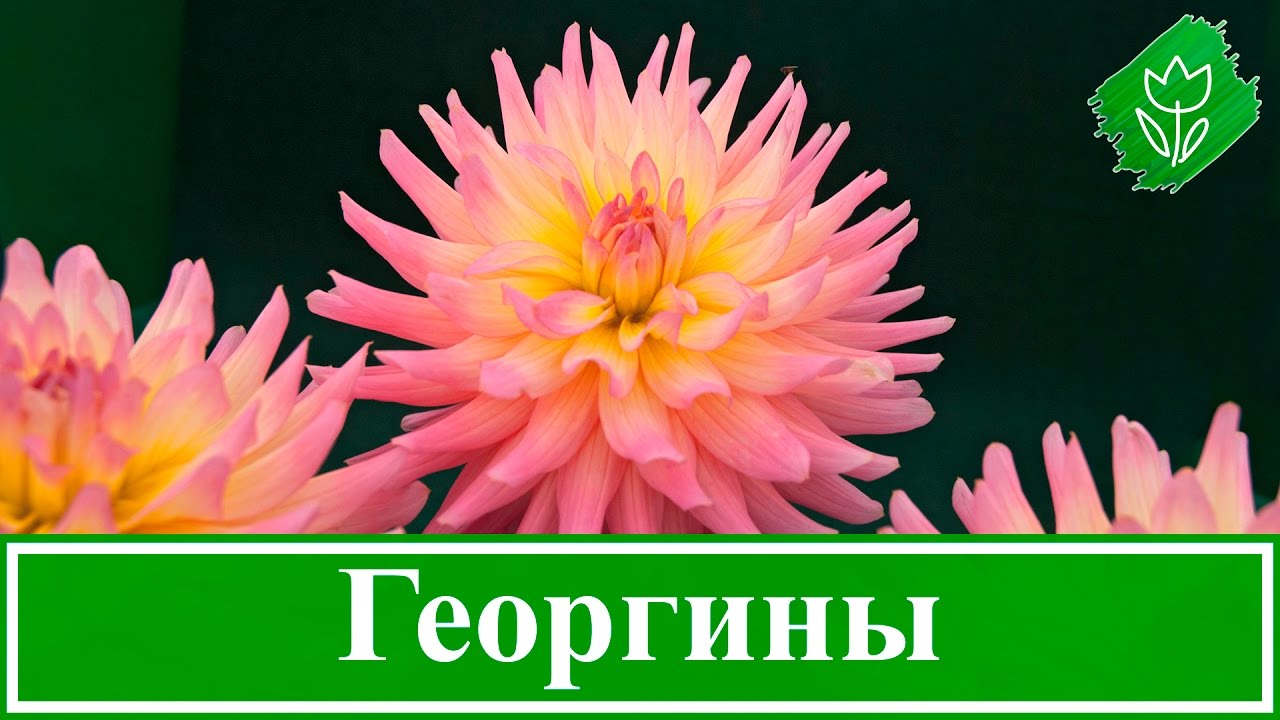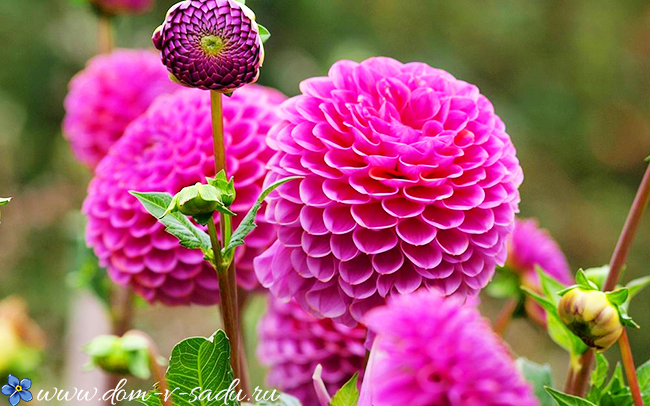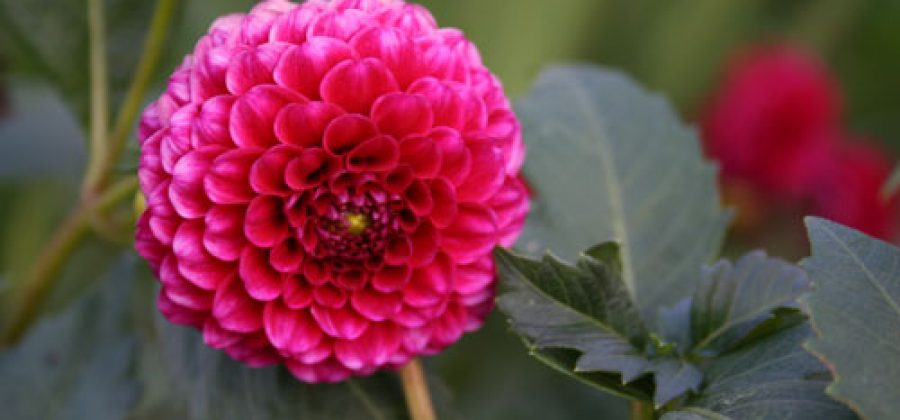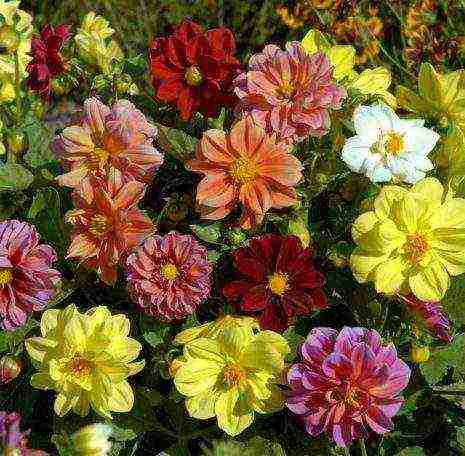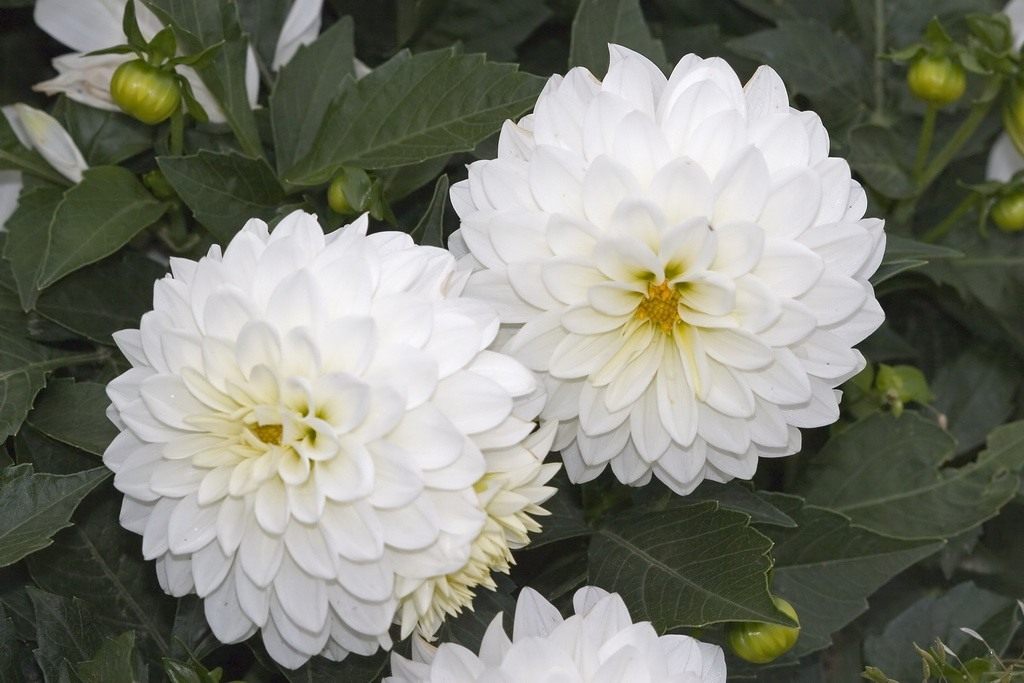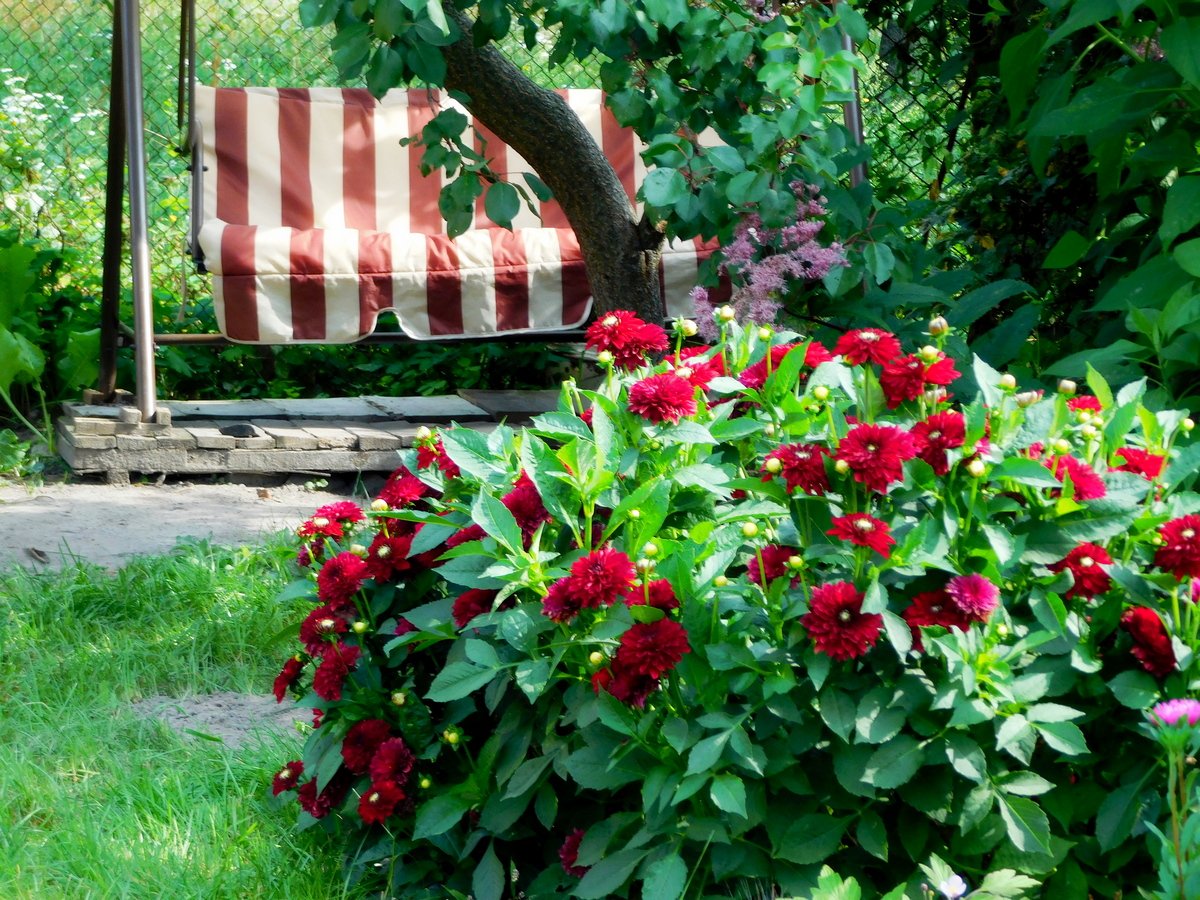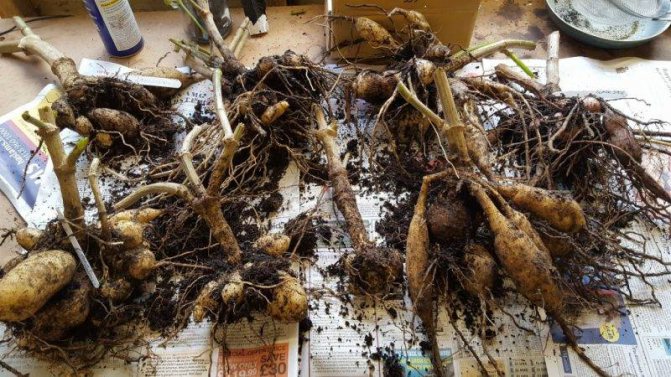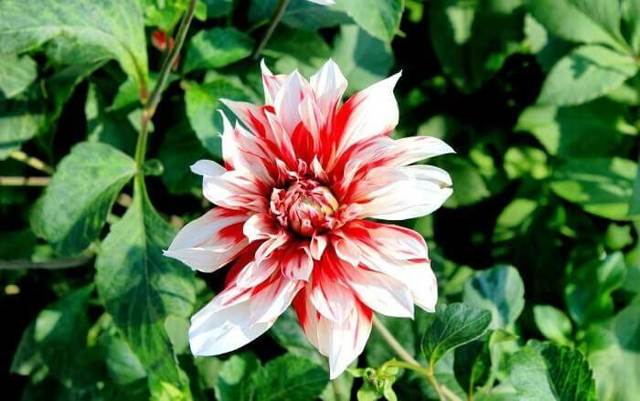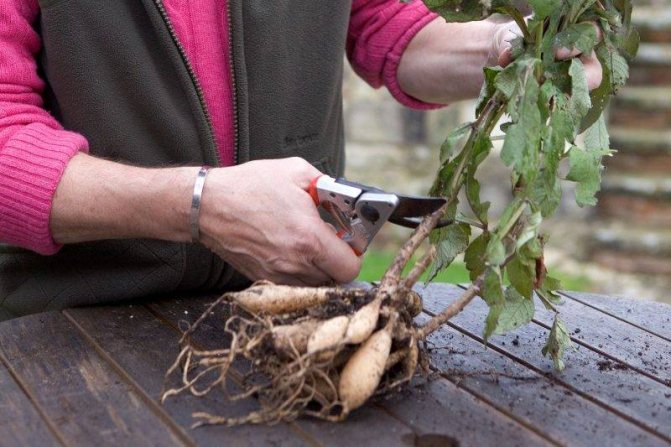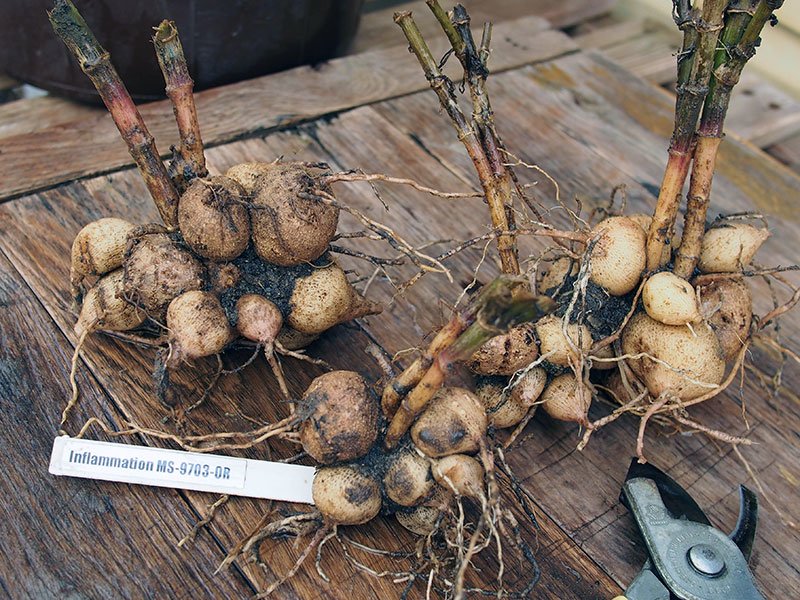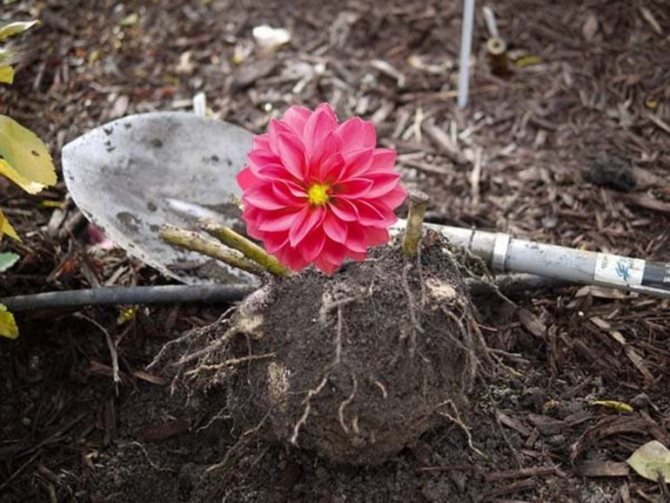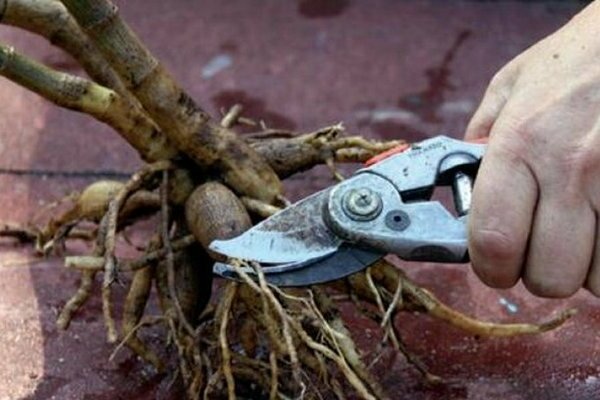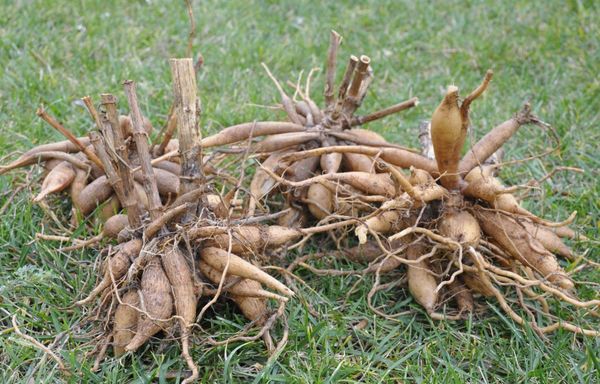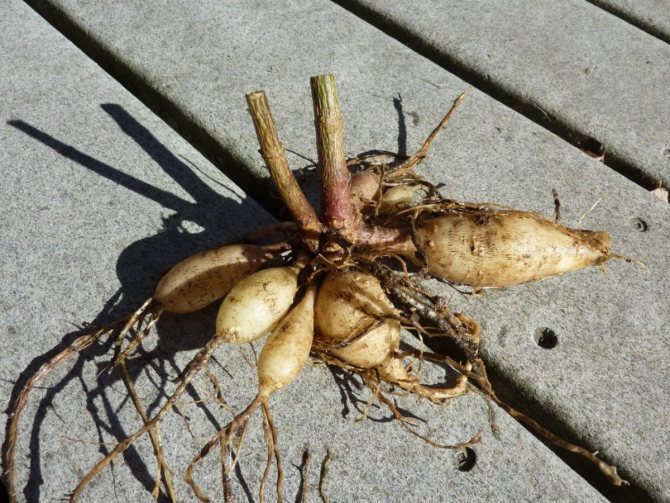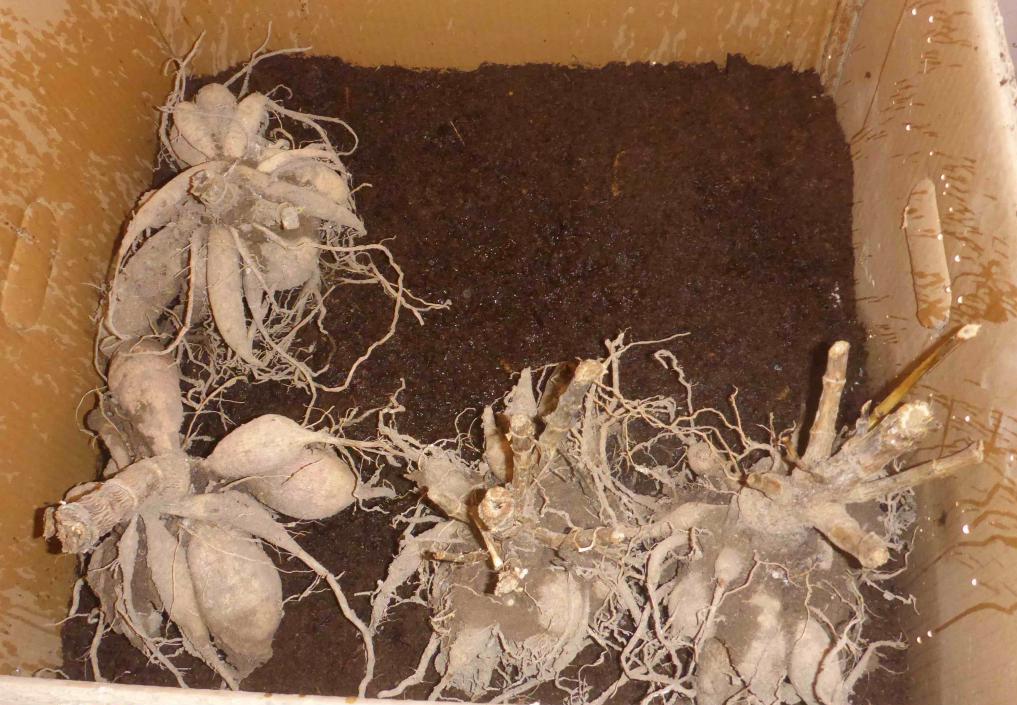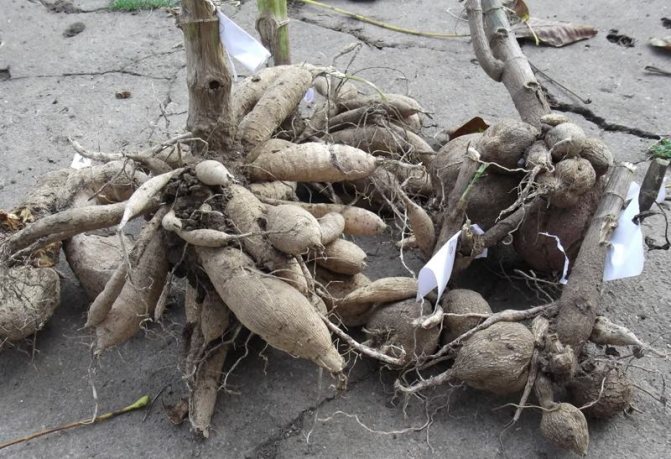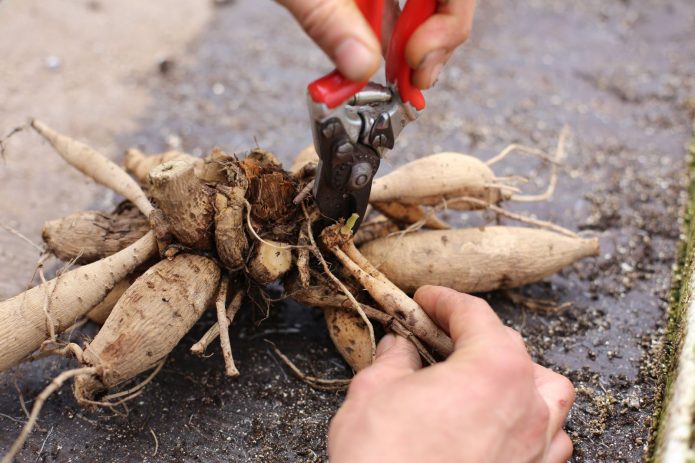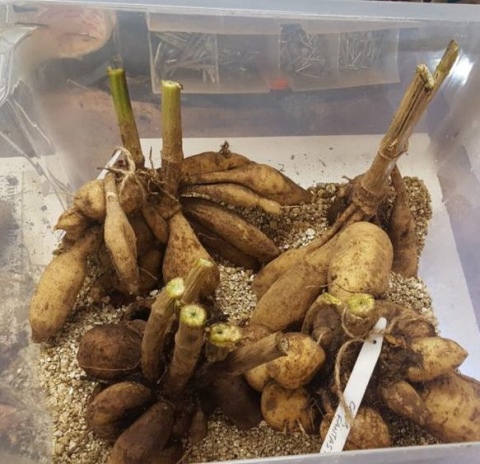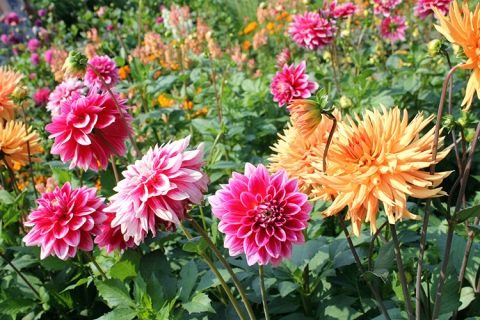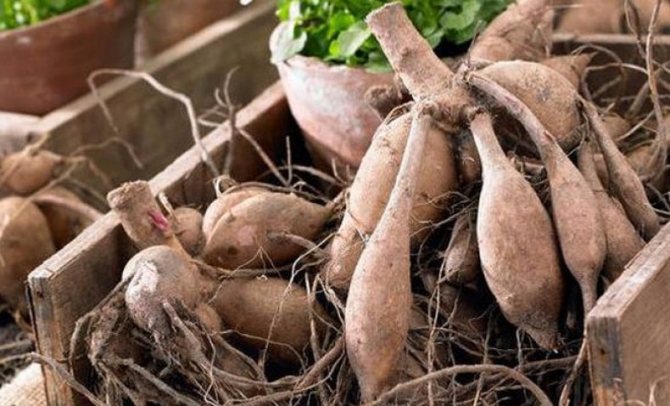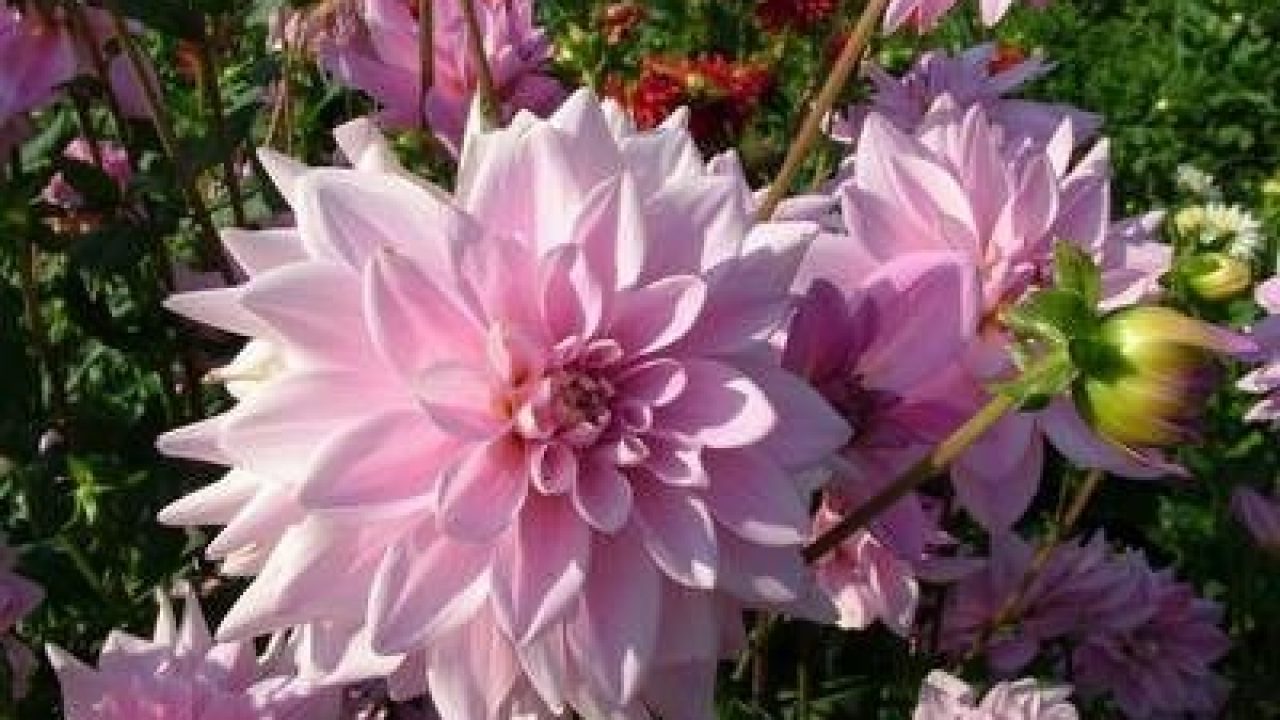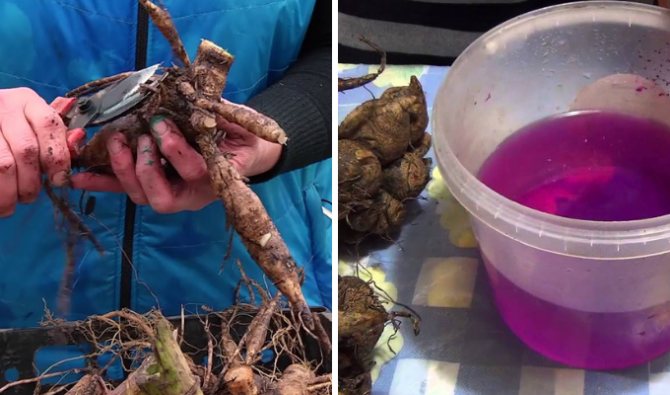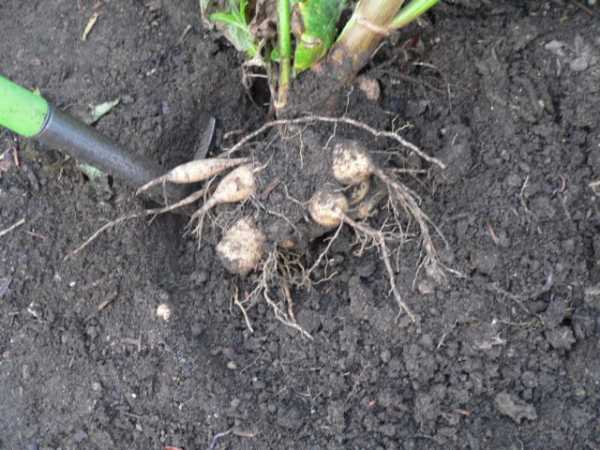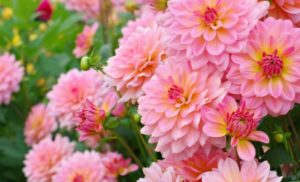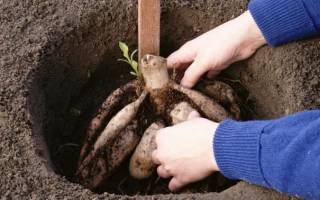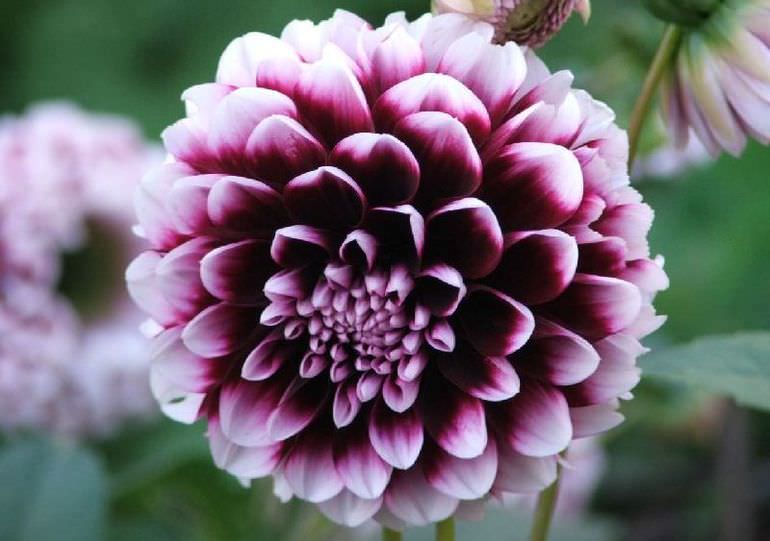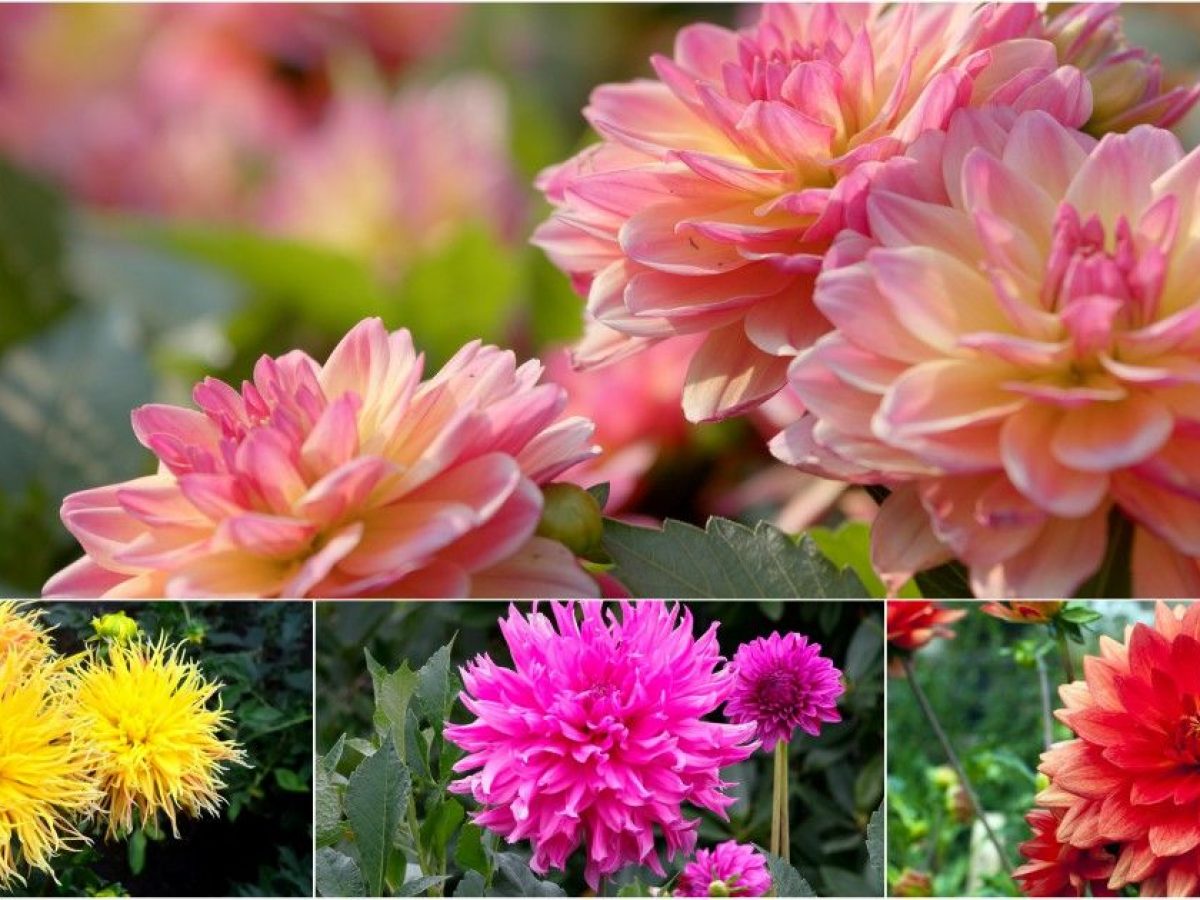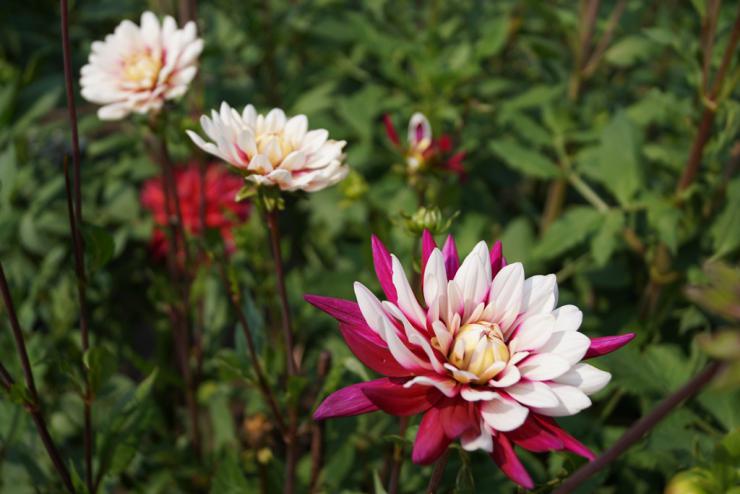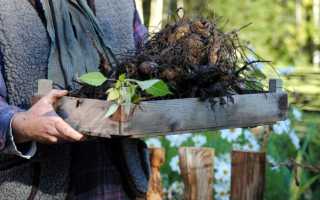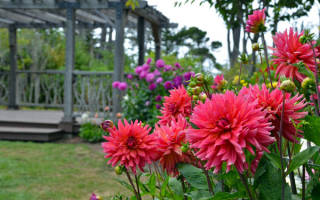Features of autumn care for dahlias
Decrease watering
Dahlia's rhizomes are powerful, dense and quite voluminous. They accumulate moisture in themselves as a safety reserve for possible drought. To avoid decay during storage, they require forced drying through a gradual reduction in the amount of moisture.
For the formation of the last buds and full-fledged photosynthesis, 1 watering per week is enough. 7-10 days before digging out the tubers, I completely stop watering.
Cleaning around the bushes
One of the conditions for good plant health is the timely removal of fallen leaves and faded parts. A variety of pests feel at ease in the well-caked remains. The danger lies in the fact that in the fall they begin to actively dig into the ground in search of a warm place for the winter. They consider the rhizomes of dahlias as an excellent opportunity to spend the winter “on everything ready”. Don't give them the slightest chance!
To do this, you just need to remove plant residues, thoroughly loosen the soil around the bushes and spill the earth with a weak solution of potassium permanganate. The measure is also effective against fungal infections, which also multiply rapidly in conditions of autumn humidity. The deadline for carrying out such work is 2 weeks before digging out the tubers for winter storage.
No top dressing!
The main part of the fertilizer for dahlias is applied in spring and summer. The nitrogen component predominates for abundant flowering and the formation of tall lush bushes. However, it is impossible to deprive the plant of phosphorus and potassium substances. They are necessary to increase immunity, accumulate strength for the next season.
At the end of July, I water my dahlias for the last time with mullein infusion and a solution of wood ash, and then I feed one potassium sulfate at the rate of 30 g per 1 plant. Lignohumat, Normat-L, Argolan, Agricola also work well.
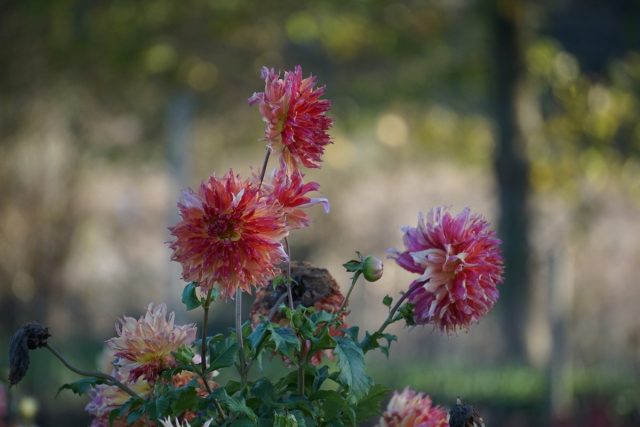 Sometimes late dahlias are "caught" by the morning frost, but tubers are not afraid of it yet
Sometimes late dahlias are "caught" by the morning frost, but tubers are not afraid of it yet
When to germinate
For dahlias, wintering ends in mid-April. But if you get these flowers later, it is possible to send them to the dacha, place them in boxes, cover them with sawdust and moisten them well. During the daytime, they are kept in the fresh air. And at night they are sent to the greenhouse and covered with several layers of film.
The time of planting flowers in the soil depends on the climate of the area. In the conditions of the middle lane, the grown dahlia tubers are planted in June, after the 1st - 10th. And if the soil warms up earlier, it is possible to do this in May (after 15-20 numbers). For planting at the end of spring, unprocessed roots with pronounced eyes are chosen. After 2 weeks, the first shoots will appear. But if the frost returns, the flowers will have to be covered.
Even if you know exactly at what temperature to store dahlias, and in what conditions, losses sometimes reach 10% of the total amount of material for planting, which must be taken into account when laying for storage.
So,
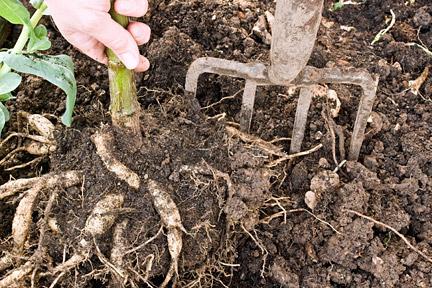
If you planted different ones in the spring and plan to multiply them or plant them in certain groups, prepare tags in advance with names or identification marks convenient for you. It is advisable to tie the tags before frost, because after them it is not always possible to determine what color your dahlia was. This is for your convenience.
As soon as the first frost passes, the greens and flowers darken, the time comes when dahlias are dug up for the winter.
You will need a rake or a small shovel. First, break off the leaves and cut the stem 40-50 cm from the ground.Later, you will cut it off, leaving 10-15 cm. This must be done so that it is convenient for you to dig out the tuber itself. Use a garden rake to carefully dig in the tuber in a circle, at a distance of about 30 cm, so as not to damage it. Then lift the tuber from the ground from different sides, try to do it smoothly.

When dahlias are dug up for the winter, in no case do they pull or stagger by the stem, trying to take the tuber out of the ground! There is another important point: when you cut the stem, there will be an empty cavity in it, into which water and moisture should not get into during further manipulations. It must be removed before sending the tubers for "wintering", otherwise the plant will disappear.
After the tuber is extracted, trim off the excess stem, leaving 10-15 cm. You do not need to completely trim the stem. Remove residual soil, rinse with water if necessary. Do not touch the thin roots at this stage.
How to prepare tubers for storage
Before preparing the dahlias for storage, we process the root tubers:
- we rinse under running water from dirt;
- we remove small plant residues;
- we spray from a spray bottle with a strong solution of potassium permanganate;
- we dry it anywhere, most importantly under a canopy, for two weeks.
Attention! When processing dahlias for the winter, save the neck. It will not work to propagate them with a piece of root.
The whole trick is in the presence of a root collar, from which buds will wake up in the future, and give growth to a new plant.
Is there a difference in perennial and annual tubers? Yes. The former have an old tuber that was left over from last year. Quite often, it rots in winter when storing dahlias.
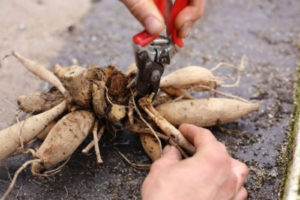
We examine the roots of not the first year of life more closely: in appearance they seem to be normal, but with dark flesh, hollow. Tap on them and a characteristic dull sound will be heard. Down with them!
Sometimes, in order to remove, you have to somehow divide the dahlia tubers: make several of one. If you can't get inside, behind the old junk - cut it boldly and store the updated dahlia tubers.
Gladiolus, Tigridia, Acidanthera
These corms are prepared for winter in the same way. At the beginning of October (if the autumn is damp, then earlier, starting from the end of September), the stems are cut, leaving 15–20 cm in length
Plants are carefully removed from the ground, so that the children do not crumble: they undermine it with a pitchfork and pull it out by the rest of the stem. After that, you can separate the baby
The planting material is laid out according to varieties and sizes in a pre-prepared container. Under the young corms, an old, shriveled corm is preserved, it is not yet separated so as not to damage the bottom. The corms and the baby are washed first in water, then in a solution of "Intavir" or "Iskra" and again in water, and then immersed in a solution of potassium permanganate. You can use the drug "Maxim".

in the photo: tigridia flower
After processing, the corms are laid out on newsprint and dried. For 5–7 days, the temperature is maintained at 25–30 ° С, ensuring good ventilation of the room, then it is dried for a month at a temperature of + 18… + 20 ° С. If the old corm is easily separated, then the drying process can be considered complete. The dried remains of the stems are cut off with scissors. Covering scales are not removed.
For storage, cardboard boxes or boxes with lids are used. Their inner walls are treated with a dichlorvos-type insecticide from a spray can (any one intended for domestic purposes will do). The dried corms are laid out by varieties in nylon bags and placed in boxes, covered with lids and wrapped in newsprint so that the insecticide evaporates more slowly. Optimum storage temperature + 1 ... + 5 ° С, relative air humidity about 80%.
Storage experience in the basement from Tatul
I have a special basin. I put new sawdust into it every year. They can be taken from any sawmill.I keep the sawdust for some time in a warm room, right in the basin, and stir it to dry it. And sometimes dry ones come across immediately. I dig up dahlias after freezing, wash them off the ground, divide, if a large root, and put them in a basin. The main thing is not to touch each other.
And, without closing the basin, I take it to the basement. In winter, I used to check for rot, but in recent years I stopped doing this, since they feel completely normal in sawdust - they are not wet and do not dry.
Also in the same basin with sawdust, for dahlias, I put all the tubers and bulbs that I dig up for the winter - gladioli, calla lilies. Every year everything winters well. At one time we tried to store it in a basin and in the sand, but it rotted. Apparently, the dampness of the basement was absorbed.
It would be very great if, as expected, before laying in the basement, soak the tubers in the "maxim" for 30 minutes. and then dry after locks. That is, wash it off the ground and immediately soak it in the "maxim". If there are invisible pests on the tubers and bulbs, they will die, and the chances of overwintering will increase many times over. I myself sometimes soak, sometimes not. I do not soak if I see that the tuber is just perfect.
If the tuber was cut during digging, then cover the incision either with ash, or brilliant green, even iodine will do, or with garden pitch, if it is at hand (with which the tree cuts are covered).
I also forgot to write a nuance. In some varieties of dahlias, the tuber is thin, such a feature of the variety. Here they are most susceptible to drying out. And even in the basement, where it is optimal for them, they can dry out. It is best to bathe such dahlias in paraffin, so as not to get upset in the spring.
What to do with dahlias you just bought in winter
I would recommend looking at those just bought.
- Everything that dangles on strings is cut off and discarded.
- If the tuber is not too dry, we put it in peat, wet newspaper, sand - and in a cellar or refrigerator.
- If the tuber is very dry, then we lay it for germination, because this will take longer to wake up or in general it is already dead at the moment, and our stores do not hesitate to sell such substandard.
To understand whether the root is alive or not, you need to cut off a small piece of tuber pulp (any), and in several places. If the cut resembles a potato tuber in color, then the dahlia root is alive, just still sleeping, and if the cut is dark brown or black, then you will have to say goodbye to the root - it will never wake up. If you find out that the root is alive, then cover the cut points with brilliant green so that no infection gets in.
Nodules that have come off the main stem can be thrown away without regret, well, or check and plant in a pot. The fact is that flower shoots are formed at the base of the old stem and extremely rarely at the top of the nodule, look carefully at your awakened potatoes and you will understand everything, or here it is:

Photo by MNBer
in the background there is an "octopus" that has grown from a small root plot - has already woken up and sprouted, and in the foreground there are 2 tubers freshly bought in the store, their tubers are small, so you can safely plant at least 1 liter in a pot and grow before planting in priming.
How to properly store dahlias in winter

The subsequent actions of the grower depend on where the tubers will be stored. The main thing is that the air temperature is between 3 and 8 degrees Celsius. At a lower temperature, dahlias will freeze, in a warmer room they will dry out and become unsuitable for planting.
Important! Keeping an eye on the humidity in the basement is a necessary parameter from 60 to 80%. With increased rates, rot develops
At low humidity, the nodules dry out.
Basement storage dahlia

If there is such a room in the country, then this is the best option for the preservation of dahlias. It remains only to choose the most suitable method of root processing.
Methods for preparing dahlia tubers for storage
| Way | Description |
|---|---|
| Clay | Prepare a mash with a creamy consistency and dip each tuber into it. Then they are dried and placed in containers |
| Paraffin | An excellent alternative to clay. Paraffin is heated in a water bath and nodules are dipped in it for a few minutes. After letting the first layer dry, the roots are again dipped into the solution. Having folded the tubers in plastic bags, they are placed in a box where sawdust is stored |
| Lime | Knead the thick solution and coat the tubers. When the coating is dry, the dahlias are taken to the basement, which is periodically recommended to be ventilated. |
| Sand | If the cellar in the house is dry, then sand is the best storage option. In this case, the owner must monitor its humidity. The method has a small disadvantage - sprouts begin to form too early. Those that grow more than 10 cm will have to be removed if an early landing is not expected |
If the summer resident is a beginner and not experienced in floriculture, then first you can try all the processing options (when there are a lot of rhizomes). This will help you choose a more suitable method for yourself in the future.
The processed dahlias are freed from the protective "casing" before germination. Paraffin is easily removed by rubbing the tubers with your hands. Clay and lime are removed by soaking in water.
How to store tubers in an apartment
It is very difficult to create suitable storage conditions in an apartment - room mode is not suitable for this. But even here you can find an alternative - a warmed loggia. Tubers are treated with clay or paraffin, put in dry sawdust, which are filled with cardboard boxes.
Another option for keeping dahlias in your apartment until spring is on the refrigerator door, away from the freezer. To do this, each root is wrapped with cling film. But then the effect of condensation will have to be taken into account. In order for the tubers not to rot, they will have to be pulled out from time to time and unfold for airing.
How to preserve with vermiculite
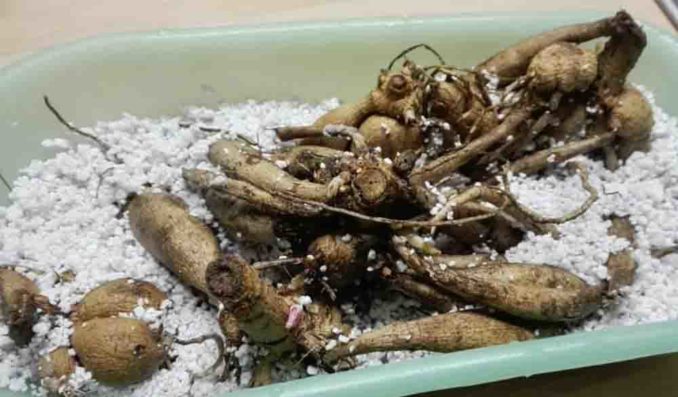
Mineral chips are actively used in garden and home floriculture: as mulch, drainage, substrate for sprouting. Vermiculite is also perfect in deciding how to store dahlias at home in winter.
The product attracts with its versatility - the mineral will allow you to save tubers not only in the basement, but also in the apartment. To do this, it will be enough to prepare plastic bags, cardboard boxes and make small holes in them for ventilation.
Vermiculite of a large fraction is poured into a container and tubers are dipped into it. Such a package can be safely stored indoors by the balcony door. In boxes with mineral chips, dahlias can be laid out in several layers.
Alternative option
You can make it easier for yourself to care for dahlias if you grow bushes in pots with a diameter of at least 10 cm. In the spring they are dug into the ground in a flower bed, and in the fall they are removed from there, after cutting off the stems.
All parts of the rhizome that look out to the surface are cut off. The earth is moistened, the pot is wrapped in newspapers, put in a dark bag and tied. They are stored in the basement, garage, on the loggia and even in the storeroom of the apartment.
Digging and culling tubers
Cutting the stems too early and digging out the rhizomes is not worth it. As long as there are green leaves and the weather is favorable, plants still accumulate nutrients.
The timing of bookmarking for the winter varies depending on the region. In the Volgograd region, for example, this time does not come until October. Very rarely, frosts fall at the end of September. If I suspect a change in weather, I cover the bushes with a film or a layer of spunbond for the night (depending on what is at hand).
From the end of August, I begin to huddle bushes every 2 weeks to protect the roots from sudden frosts. After flowering, I cut the stems to a height of 12-15 cm from the ground level, sprinkle with mulch.
As soon as the first frosts have begun, you can start digging the tubers. For this I choose a dry sunny day, preferably without wind.Gently dig in the bush from all sides and, holding on to the cut stumps, at the same time lean on the shovel. The tubers come out completely without damage or cuts.
The most crucial moment is a captious examination and rejection of diseased or damaged tubers. At the slightest suspicion of a fungal infection or the presence of a pest in the pulp of a tuber, I put it aside. If there is enough material for the next year, then all defective parts are burned.
In my experience, treating them by cutting and soaking them in preparations is almost useless. I immediately dispose of the affected bushes along with a lump of earth, and spill the garden with any fungicide. I also reject plants that have not given a single bud, weakened and with overly thin stems. They won't be of any use next year either.
 For digging dahlia tubers, I choose a dry sunny day, preferably without wind
For digging dahlia tubers, I choose a dry sunny day, preferably without wind
Planting dahlias in the ground
Planting of plants (both cuttings and those grown from divided tubers) is carried out in pre-prepared areas with spaced stakes and holes dug around them. The approximate distance between plants is set at half the height of an adult plant (from 60 to 100 cm in a row), the distance between rows is at least 100 cm. Stakes should be strong, 160-180 cm high. Coniferous stakes are more durable. For their long-term preservation, it is necessary to impregnate the lower part of the stakes with special compounds, for example, 7% iron sulfate, and paint the stakes themselves with green paint. More durable and comfortable metal stakes. To do this, use old unusable pipes or pieces of reinforcing steel with a diameter of 12-20 mm. The stakes are driven to a depth of 40 cm. After that, a plant is planted closer to the stake (with water in the hole) so that the tuber neck is 4-5 cm below ground level.
Preparing dahlias for winter and storing them at home
Dahlia - This flower is native to Central America, so it does not tolerate frost. In order to preserve it, the tubers must be dug up and harvested until spring in a suitable place.
 Many gardeners are interested in how to store dahlia tubers in winter, as they often do not survive until spring, rot or dry out.
Many gardeners are interested in how to store dahlia tubers in winter, as they often do not survive until spring, rot or dry out.
Somewhere from mid-August, dahlias need to be hilled to strengthen the stems, as well as the formation of strong and large roots. Watering should be moderate to prevent rot and mildew from forming around the tubers. Towards the end of September, dahlia are dug up. If the plant undergoes several small frosts of 0.1 degrees in the ground, then this hardening will help it better endure wintering.
 If you provide dahlias with proper care and storage, then usually no problems arise.
If you provide dahlias with proper care and storage, then usually no problems arise.
Remove excess soil, cut off the stems, leaving 5-8cm. from the root and extract it from the ground. Digging is best done with a pitchfork, so as not to damage the root system. It is impossible to wash the soil, it can be shaken off after drying. Stem sections are treated with dry lime or wood ash and kept for about seven days at room temperature. This time is enough for the stems to become coarse and the roots are completely dry.
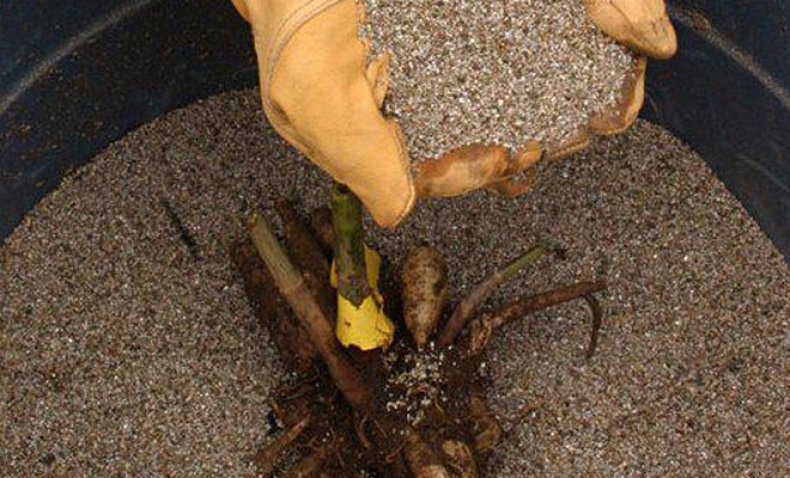 Dahlia tubers are dug up after the onset of frost, usually in late October - early November.
Dahlia tubers are dug up after the onset of frost, usually in late October - early November.
Spray the plant with a fungicide or mild manganese solution during wintering to prevent disease and dry it again. If a root immersed in a liquid floats, it is thrown away. He won't make it to disembark. Remove old, thin and damaged tubers.
When storing dahlias, it is important to maintain good ventilation, correct temperature and humidity. If you live in a private house, then it is better to dry the plant in a greenhouse or veranda, and a window sill will be an excellent place in the apartment.
Make tags with the name of the variety, the color of the dahlia, and attach to the stems. The ideal storage temperature is +5 degrees.Throughout the winter, inspect roots and stems to prevent them from drying out, rotting or sprouting in time.
If you live in a private house, then it is better to dry the plant in a greenhouse or veranda, and a windowsill will be an excellent place in an apartment. Make tags with the name of the variety, the color of the dahlia, and attach to the stems. The ideal storage temperature is +5 degrees. Throughout the winter, inspect roots and stems to prevent them from drying out, rotting, or sprouting in time.
 At higher humidity, the tubers will rot, and at low humidity, they will dry out.
At higher humidity, the tubers will rot, and at low humidity, they will dry out.
SIMILAR MATERIALS
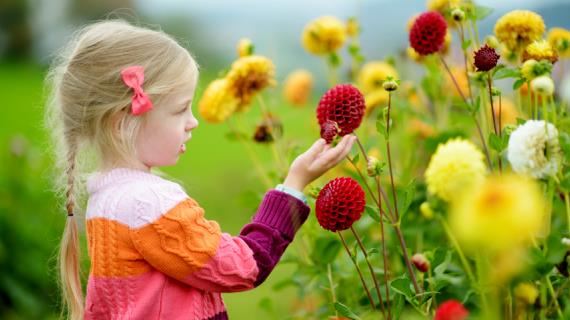
Growing dahlias is easy and any beginner can handle it. For the first time in Europe, dahlias ...
3
10
The most difficult part of growing dahlias is their winter storage. Many old varieties, of course, do not ...
1
19
It's autumn, and the gladioli on your site have faded? It's time to send their corms ...
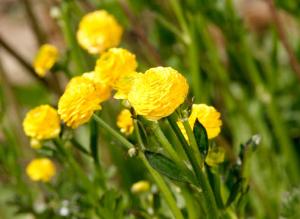
40
Ranunculus are placed in groups of several plants or in large arrays on flower beds, ridges, in ...
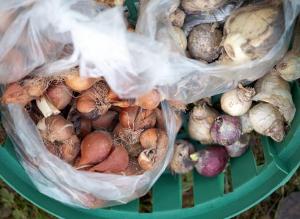
1
2
Autumn is a benefit of tubers and bulbs. Some crops at this time are dug up and harvested on ...

2
2
Most bulbous blooms enchantingly, but not for long and do not shine with beauty the rest of the time. That's why …
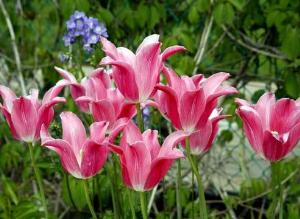
2
Bulbous and small-bulbous are different groups of plants. But for those, and for others it was ...
Preventive examination

Sampling of affected plants should be done with extreme caution.
All plants have to go through it. If a gardener finds dahlias affected by this or that disease, dried up on the vine, he will have to dig them out with a lump of earth and burn them in order to stop the spread of infection to neighboring crops. Typical signs of infestation are white mold caused by fungus, brown spots, rot, and suspiciously rapid drying of the stem and leaves of the dahlia.
Non-viable plants are also subject to rejection, which for the whole summer have never gathered buds, whose stems are too long and fragile. Unfortunately, one cannot expect that the result will be different next season.
When to dig in the fall
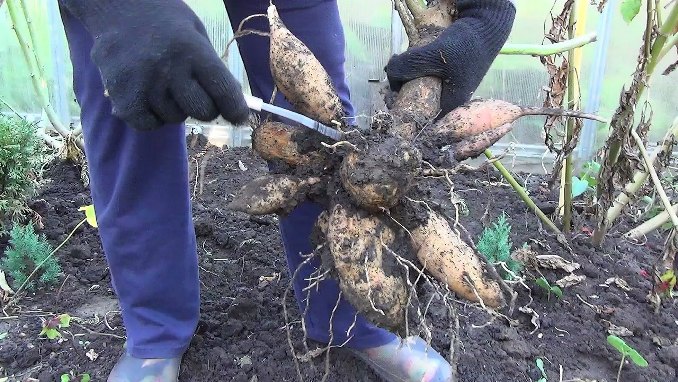
It is advisable to dig up the corms within the recommended time frame. If you get them out of the ground too early, dahlias will suffer storage worse, because in the soil at above-zero temperatures, they are provided with the optimal temperature and humidity. And when the gardener is late in time, the risk is too great that the bulbs will die due to freezing. For this procedure, each region will have its own optimal timing.
In outskirts of Moscow
Tuber formation begins in spring and ends after flowering in mid-autumn. It is such a ripe bulb that is full of strength for a successful wintering. The signal to the fact that it is time to dig up dahlias will be the drying and wilting of their aboveground part.
If the frosts are short-lived, you can let the tuber sit in the ground, slightly huddling the plants. But, of course, one cannot wait for severe frosts. In central Russia, and in particular in the Moscow region, the optimal time for excavation is from early to mid-October. Although weather conditions can make adjustments.
In the Urals
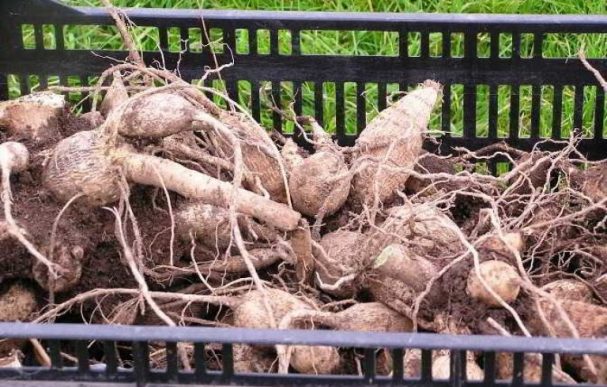
The Ural belongs to the northern regions, although its great length implies the difference in climatic conditions in different regions. Nevertheless, autumn comes here earlier than in the middle lane. With an unexpected onset of severe frosts, the roots will begin to rot and the tuber, saving itself, can awaken growth buds.
In this case, it will hardly be possible to save it until spring. If sub-zero temperatures come unexpectedly, you need to have time to dig up the corms of the dahlias within the next 3 days. General recommendations for the Ural region prescribe to remove the onions from the soil at the end of September, while the weather has not deteriorated much.
In Siberia
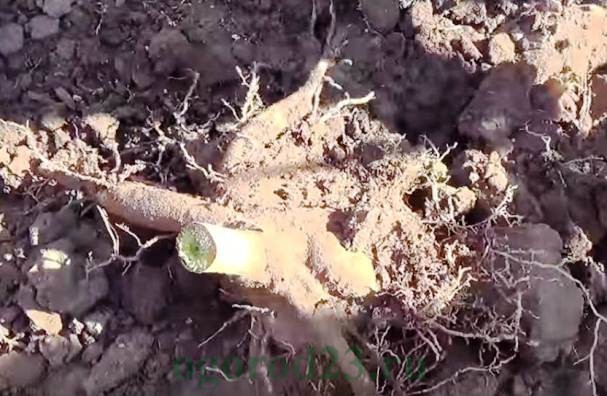
Siberia has a short summer. Crops with a short growing season are grown here. Breeders take this into account when breeding zoned varieties.Dahlias, suitable for cultivation in Siberian climates, fully ripen one month after flowering. The timing of digging also depends on the color of the petals.
Varieties with dark inflorescences are dug out earlier than others. The last ones to be extracted are the specimens that were grown from annual tubers. The vagaries of the weather can affect the timing of the extraction of the bulbs. If autumn is early, the procedure is carried out in mid-September. In persistent warm weather, you can postpone digging the bulbs for another 1-2 weeks.
In Belarus
Belarus has a continental climate with warm summers and cold winters. In general, it is characterized as soft and moist. On the territory of Mogilev and Minsk regions, weather conditions are comparable to the climate of central Russia. Dahlia bulb digging times will be about the same.
You should only dig up the nodules a little earlier if the autumn is rainy. You need to focus on weather conditions. In general, we can say that it is necessary to start extracting tubers from the ground in the period from October 1 to 15.
According to the lunar calendar for 2018
Those who adhere to the recommendation of the lunar calendar, in order to dig up the tubers of dahlias, need to meet the following deadlines:
- September - 1-6 (up to 17 hours), 10-19, 23, 24, 26-30;
- October - 1-3, 7, 8, 10-16, 20-23, 25-30.
Proponents of this approach argue that if you work on favorable days, it will be better to keep the bulbs healthy and strong until spring.
Dahlia storage rules until spring
Preparation
Before laying for home storage, many growers divide the bulbous nest into parts, leaving along the neck with buds and cutting off all remaining roots and shortening the stems to the maximum possible length.
Separation allows you to store planting material without the appearance and spread of rot.
In the process, the tubers are examined and sorted, cutting out rotten fragments to a healthy layer, processing them after pruning with brilliant green. Leave only those that, as a result of the sanitary procedure, have retained at least 1/3 with the kidneys. Smaller delenki are thrown away.
The presence of holes indicates pest damage, but is not an obstacle for storage.
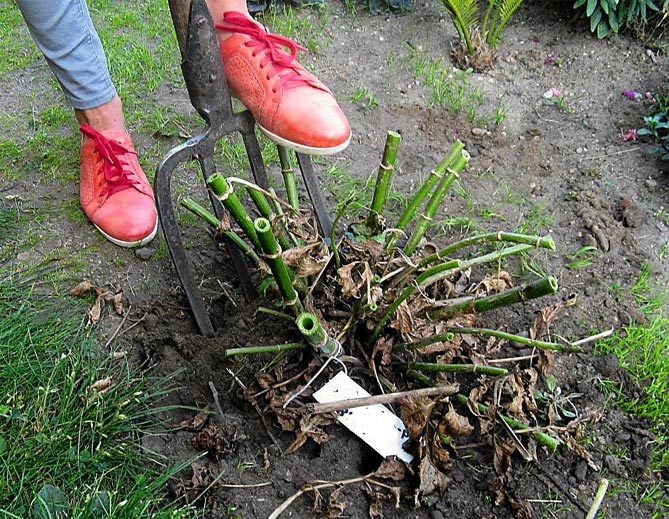
Completely discolored necks that have begun to deteriorate should not be bookmarked.
Onion cuttings are washed with water, the sections are treated with a fungicide and left for 6-10 days to tighten the wounds on the roots and form a thin crust on the surface, preventing excessive evaporation of moisture.

It is not worth preserving the uterine root of the plant, because he will give only weak shoots in the next season.
Garden, vegetable garden and flower garden tips
Salting cabbage at home recipes quickly and tasty
How to store cabbage in the cellar until spring
When to ferment cabbage in October 2019 according to the lunar calendar
The necessary conditions
Before sending for wintering, root tubers should be marked so as not to confuse varieties. This will make it easier to plant flowers for the next season.
Correct microclimate:
temperature within 3-7 ° С;
humidity from 80% and above;
well-organized ventilation;
isolation of root tubers from each other, avoidance of contact;
laying with the root collar downward.
A small amount of planting material is stored in the refrigerator, avoiding the proximity with vegetables, because high humidity becomes the cause of fungal diseases.
A large volume is placed in separate containers - buckets and plastic or wooden boxes, cardboard boxes and placed in the basement, on the balcony or in the cellar.
In any method of laying, the tubers are shifted with an auxiliary substrate or a suitable material.
Wood sawdust. A simple and affordable method to save planting material. A coarse fraction or shavings are suitable, because fine sawdust will dry out the bulbs, drawing out all the moisture. Layout is possible in 2 rows with sprinkling with a layer of sawdust.
Peat.A horseman approaches, with which they fall asleep the boxes laid out in wooden boxes, leaving the necks half open. In winter, the peat layer is moistened to prevent the dahlias from drying out. Peat can be mixed with garden soil in a 3: 1 ratio.
Earth. Bulbous cuttings are laid out in boxes lined with newspaper or paper and sprinkled with earth.
Sand. River sand for backfilling planting material in storage tanks must be dry. The roots are immersed in 1-2 layers and covered with burlap on top. In winter, the sand is not moistened.
Packages. Tubers are stored in polyethylene together with sawdust that absorbs moisture, otherwise the process of rotting root tubers will begin from the formation of condensation. The bag is tied, but holes are made over the entire surface for air access. Once every 2 weeks, the material is inspected for the appearance of mold and rot. The damaged copies are discarded.
Film. Each section is treated with a fungicidal preparation or sulfur powder before laying, wrapped in a film, folded into a cardboard box.
Bags. Dahlias are stored in canvas bags dry, without filler, hanging them at a height in the basement, apartment, cellar, avoiding contact with the floor, away from damp places.
Paraffin. The most effective method, providing the highest percentage of safety. Suitable only for early varieties of dahlias, because after waxing, it is possible to wake up the bulbs much later. Recommended for storing rare varieties. The paraffin is heated to a liquid state in a steam bath and allowed to cool to an acceptable temperature. Each onion cut is lowered and held until a waxy crust forms. After processing, the root tubers are folded into a bag with sawdust and stored in a cool place.
Clay. Like paraffin, it covers the root tuber with a protective layer and increases the shelf life. The clay is diluted to a thick state and the roots are dipped into it, allowed to dry and sent to a suitable container.
Vermiculite. Granular material is suitable for pouring dahlias when they are stored in boxes or plastic bags. It is not used in rooms with low humidity, because it absorbs a significant amount of moisture from the surrounding air. When laying in boxes, layers of vermiculite substrate and root tubers alternate.
I love this article!
Dahlia root storage methods
Storing the dahlia in paraffin prevents root drying and mold growth during the winter. Take several candles, grate them on a coarse grater and heat them in a water bath to 60 degrees. Then dip the tubers in paraffin with tongs, remove and let cool. Repeat the procedure to thicken the protective layer. Now the roots can be folded into bags and stored in a dark place. In the spring, before planting, the paraffin protection must be carefully removed so as not to damage the planting material.
 Dahlia roots waxing.
Dahlia roots waxing.
The use of vermiculite.
Vermiculite is a non-toxic resinous mineral with thermal insulation and anti-mold properties. Place prepared tubers in perforated bags. Sprinkle them with vermiculite, and your dahlias will perfectly endure the winter in the apartment.
 Dahlia roots in vermiculite.
Dahlia roots in vermiculite.
In boxes with sawdust.
Take small sawdust - this is a fairly common natural material. Pour them on the bottom of the box, then arrange the dried tubers in one layer. So keep styling to the brim
It is worth paying special attention to the storage space, since choosing a room that is too warm can lead to rapid drying of sawdust and loss of moisture in the tubers, which should not be allowed. If it is not possible to choose a room that is suitable for the temperature, the box with a dahlia must be periodically sprayed with water, but not too abundantly, as this can lead to the formation of mold
 Dahlia roots in a box of sawdust.
Dahlia roots in a box of sawdust.
In boxes of sand.
Storing dahlias in sand is suitable for those who have a cellar, as it actively draws in moisture - this quality in a dry room can lead to the drying out of the root system of the plant. Room humidity should be around 85%. You can use a box or bucket to stack the tubers. Pour a little sifted and dry sand on the bottom, you can spread the planting material on it. When the container is full, the roots must be carefully poured on top to prevent air from entering.
 Sand for storing dahlia roots.
Sand for storing dahlia roots.
In a clay shell.
Prepare a clay mortar. For this method, dilute it to a thick sour cream consistency. Dip the dahlia tubers in the solution and let dry in the open air until a hard crust appears, in a gazebo or balcony. In the spring, before planting, the carapace should be carefully removed. Clay can partially remain on the tubers; its complete removal is not essential. The main thing is not to damage the dahlia, and the remaining crust will dissolve in the soil after planting.
 Storing dahlia roots in clay.
Storing dahlia roots in clay.
In the film.
For this method, the roots of the dahlia are first treated with sulfur powder or fungicide, then wrapped with a film several times. After this procedure, the tubers are placed in boxes and stored in a dark room.
 Foil wrapping of dahlia roots.
Foil wrapping of dahlia roots.
In the peat.
Many flower growers use peat for storage. The principle of application is the same as with other substrates. Do not replace peat with moss. In a damp room, it will intensively absorb moisture, which will lead to the formation of mold and rot. In a room that is too dry, the moss will draw out the juices from the tubers, and they will dry out.
 Peat for storing dahlias in winter.
Peat for storing dahlias in winter.
In pots.
Pick up pots with a circumference of about twenty centimeters. Grow a dahlia and store the root in it. Fill the pot with nutritious soil, plant the flower and dig it into the ground so that the edge protrudes about 1 cm above the surface.Tubers of a dahlia planted in this way will be smaller and will be better preserved.
 The room should be dark. Otherwise, the kidneys will wake up and start growing.
The room should be dark. Otherwise, the kidneys will wake up and start growing.
In the fall, cut off the stem and dig up the flower along with the pot. Separate thin roots and protruding tubers. Wrap everything with paper or newspaper in several layers and put it in a bag to exclude light from entering the plant. Put it in the cellar, pantry. In the spring, take it out and start watering until the buds form. Then remove the roots and plant. If watering and germination is prolonged for 2-3 weeks, then shoots will appear and they can be used for cuttings.
 Tubers should be inspected monthly and rotten ones should be removed so that all planting material does not deteriorate.
Tubers should be inspected monthly and rotten ones should be removed so that all planting material does not deteriorate.

